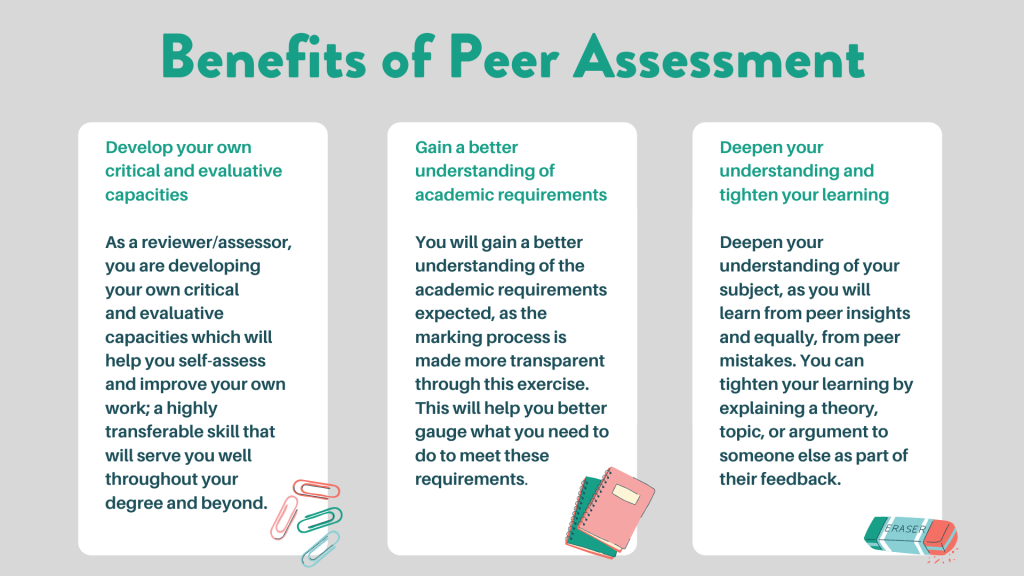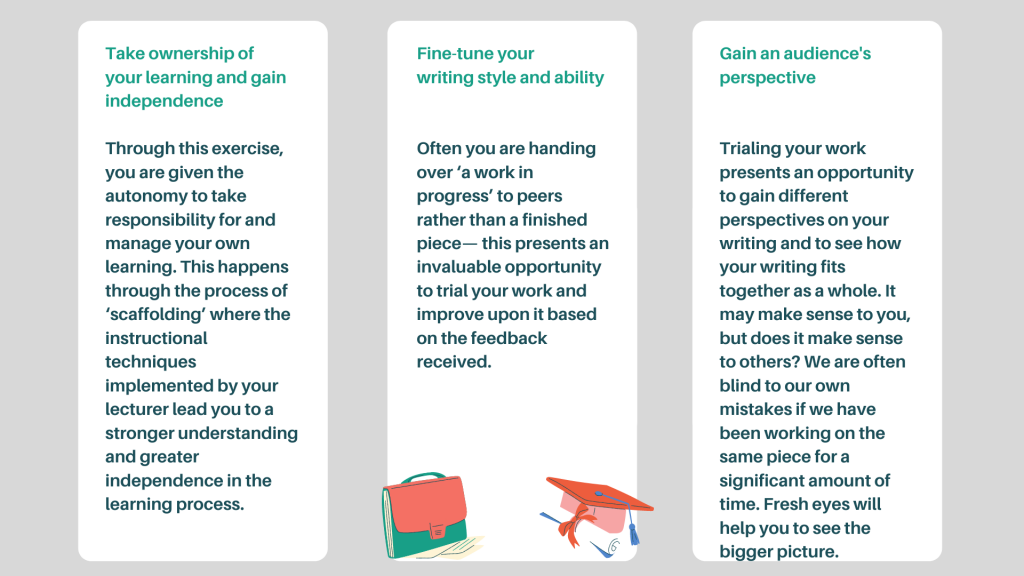A Student Guide to Online Peer Assessment

At some point during your time at Queen’s, you may be asked to undertake peer assessment, peer review, or provide peer feedback. This can be a daunting prospect as you may feel ill-equipped to provide feedback to your peers, feel uncomfortable about doing so, or just cannot envisage what insights a learner of similar status/ability could offer. These are common concerns, though peer assessment needn’t be an ordeal and is proven to be largely beneficial to the learning of both the reviewer and the reviewee.
This is part 1 of 2 in a series on peer assessment — Through this blog post, we hope to alleviate any concerns you may have and help you realise how peer assessment can enhance both your learning and confidence in your field. Some of the terms used here may be new to you, so a few definitions will be provided along the way.
What is peer assessment?
Peer assessment is the process whereby students assess the work of their peers against set assessment criteria, under the direction of their tutor/lecturer who moderates. It can be summative; involving the assignment of grades or formative; where students are engaged in providing peer feedback. For this reason, the term is sometimes used interchangeably with the term ‘peer review’. It can also be a combination of both formative and summative assessment.
A digital focus
As this blog has been written amid a pandemic, it will be no surprise that a proportion, if not all of your peer assessments will be taking place online. Peers might email each other drafts for comments, send video/audio recordings of feedback, organise an online face-to-face feedback session, or may provide feedback through a dedicated discussion forum set up by the lecturer.
Familiarise yourself with the learning objectives, outcomes, and assessment criteria
The first step of peer assessment should always involve reviewing the learning objectives, outcomes, and assessment criteria. Make sure you are clear on what you are to look for in a piece of work. As ever, your lecturer will guide you through this process.
- A learning objective is a statement that defines the expected goal(s) or purpose of a particular module or course.
- A learning outcome is a statement that describes the specific, measurable knowledge, skills, abilities, or values that you, as a student, should be able to demonstrate upon the completion of a particular class, assessment, module, or course. It is there to help you understand why these will be useful and to help manage your expectations.
- Assessment criteria provide information to students on the factors which will be taken into account when marking a piece of work; and the standards that a student has to achieve on each criterion to be awarded a mark within a particular grade level.
Practice makes perfect…
Understanding how to apply assessment criteria is a skill that is honed over time. It won’t be perfected overnight, so don’t worry if you don’t get it the first time, you will learn with practice. In addition to assessment criteria, your lecturer may provide you with set guidelines or rubrics with clearly defined tasks for you to perform as a reviewer/assessor.* Use these as your guide when appraising your peers’ work and if in doubt, check with your lecturer.
What’s in it for me?
As previously mentioned, a common concern with peer assessment is that students cannot envisage what insights a learner of similar status/ability could offer, or they just can’t see the point of peer assessment. Whilst these may be valid concerns, the feedback or grade you receive from peers should not be the sole motivating factor of engaging in peer assessment. The exercise itself forms part of a structured learning process from which the benefits are numerous.
The table below outlines some of the benefits you may experience as part of peer assessment. Needless to say, you will only reap the benefits through full engagement.


Now that you’ve grasped the basics of peer assessment, you’ll be ready to read part 2 of this series — It’s all about how best to give and receive feedback.
Pages: 1 2